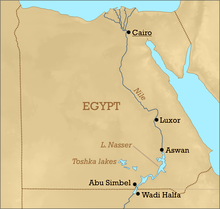Toshka project

As Toshka project (also Südägyptisches development project , english South Egypt Development Project ) is a project of the Egyptian designated government that the desert in the southwest of the country through irrigation for agriculture to make it usable. Large amounts of water are pumped from the Nasser reservoir into a canal and channeled into a strip of desert parallel to the Nile .
aims
The main goal is to relieve the Nile Valley , in which almost the entire population of Egypt lives on around 5% of the land area. Due to the strong population growth and erosion , the agricultural area there is decreasing. Initially, export-oriented agriculture and cattle breeding are to be practiced in the new valley , later, thanks to the rich deposits of raw materials in this area, mining and the metal industry , fish farming and tourism will also be carried out . In addition to existing roads, railways are also planned as the infrastructure . The Aswan Dam provides electricity . By 2017 [obsolete] , the Toshka project is expected to create jobs and apartments for 3 million people on an area of 420,000 hectares. In this way, the settlement area of Egypt is to be increased from currently 5% of the country's area to over 20%.
Mubarak pumping station
The center of the project is the Mubarak Pumping Station ( Mubarak Pumping Station ), which pumps the water of the Nasser Reservoir over 50 m high into the Sheikh Zayed Canal. The pumping station, located about 60 kilometers north of Abu Simbel directly on Lake Nasser , consists of a concrete structure and is about 30 m wide, 140 m long and 60 m high and houses 24 vertical pumps . Eighteen of them should be in constant operation, while three pumps each are serviced or kept in reserve. 25 million m³ of water are taken from the lake every day in this way. This makes the Mubarak pumping station the largest of its kind in the world. It was officially inaugurated on January 12, 2003, but was not put into operation until later because the Sheikh Zayed Canal was not yet completed at that time.
Sheikh Zayed Canal
The second key element of the project is the Sheikh Zayed Canal. Despite the enormous evaporation , especially in summer , the canal was preferred to a pipeline , probably due to the large amount of water to be transported of around 25 million cubic meters / day. This corresponds to the content of a medium-sized German dam. The main channel with a width of approx. 35 m leads from Lake Nasser 50 kilometers west into the desert . There it branches off to the west and south into four approx. 25 m wide side channels, each of which is supposed to supply large areas of around 40,000 ha to 80,000 ha with water. The 8 m deep channel consists of a cement - sand mixture, which is sealed with a concrete layer and a polyethylene layer and an additional protective coating. The great effort is made to prevent the seepage of water. The agricultural areas are preferably irrigated with water-saving drip irrigation , but large-area irrigation is also found. Compared with the tiny Fellach pieces in the Nile Valley, the areas that have been created so far are economically sensible. There are often irrigation areas with a diameter of approx. 800 m each, but they require considerable capital investment.
financing
The project is financed by the Egyptian government, which is providing the infrastructure , as well as with private funds from Saudi Arabia and the United Arab Emirates . The construction of the Mubarak pumping station, which was financed by Egypt, alone cost around US $ 560 million. The Saudi Prince al-Walid ibn Talal has also made high investments with his Kingdom Agricultural Development Company (KADCO). Sheikh Zayed , former President of the United Arab Emirates , has provided around 100 million US dollars for the construction of the canal that is named after him. In total, costs of over 60 billion euros are expected by 2017.
Problems
The Toshka project is not only highly controversial in Egypt . Critics fear that the soils in the irrigated areas could become too salty and thus become sterile. In general, there are different views on the fertility of the soil in this area, so it may be necessary to use a lot of artificial fertilizer to achieve the desired yields. Because of the project, water consumption in the other parts of the country must also be reduced, as Egypt is only entitled to a limited amount of water from the Nile at 55.5 billion cubic meters per year . This amount has already been exceeded, which can lead to problems with other Nile countries such as Sudan .
state of things
Both the pumping station and the canal are currently completed. Some areas are already managed (8,400 hectares out of a planned 175,000 hectares) while others are still being prepared. Mainly table grapes and melons are grown. Potatoes are successful on the European market and can be grown here practically all the time, which means that one can escape the European seasonal differences. The soil quality also seems to be better than expected. However, independent information is difficult to obtain as Egypt regards the project as a prestige project and is unlikely to publish any critical facts.
See also
Web links
- http://www2.klett.de/sixcms/list.php?page=geo_infothek&miniinfothek=&node=Toshka-Projekt&article=Infoblatt+Toshka-Projekt
- http://www.water-technology.net/projects/mubarak/
- http://www.thenational.ae/news/world/middle-east/egypts-new-nile-valley-grand-plan-gone-bad
- http://www.mwri.gov.eg/En/project_toshka%20.html
Coordinates: 23 ° 0 ′ 33.9 ″ N , 31 ° 30 ′ 53.3 ″ E

